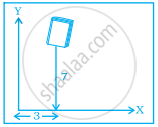Advertisements
Advertisements
Question
A point which lies on both the axis is ______.
Options
(0, 0)
(0, 1)
(1, 0)
(1, 1)
Solution
A point which lies on both the axis is (0, 0).
Explanation:
We know that, the axes are two mutually perpendicular lines intersecting each other at the point (0, 0) also known as the origin.
Hence, the point which lies on both the axes is (0, 0).
APPEARS IN
RELATED QUESTIONS
In the given figure the position of the book on the table may be given by ______.

The x-coordinate of any point lying on the y-axis will be ______.
The y-coordinate of the point (2, 4) is ______.
In the point (4, 7), 4 denotes the ______.
In the coordinates of a point, the second number denotes the ______.
Write the y-coordinate (ordinate) of the given point.
(3, 5)
Make a line graph for the area of a square as per the given table.
| Side (in cm) | 1 | 2 | 3 | 4 |
| Area (in cm2) | 1 | 4 | 9 | 16 |
Is it a linear graph?
Locate the points A(1, 2), B(3, 4) and C(5, 2) on a graph sheet taking suitable axes. Write the coordinates of the fourth point D to complete the rhombus ABCD. Measure the diagonals of this rhombus and find whether they are equal or not.
The following table gives the growth chart of a child.
| Height (in cm) | 75 | 90 | 110 | 120 | 130 |
| Age (in years) | 2 | 4 | 6 | 8 | 10 |
Draw a line graph for the table and answer the questions that follow.
- What is the height at the age of 5 years?
- How much taller was the child at the age of 10 than at the age of 6?
- Between which two consecutive periods did the child grow more faster?
